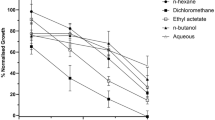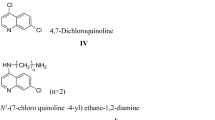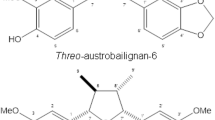Abstract
FOR centuries in China the roots (Chang Shan) and the leaves (Shuu Chi) of Dichroa febrifuga, Lour, have been used against malarial fevers. In our first report1 in 1943, it was recorded that a crude extract of this root had been effectively used on clinical cases of tertian malaria. Then in 1945, when Plasmodium gallinaceum became available to us, we found that the crude extracts of both the root and the leaves of the herb were also effective for chicks infected with P. gallinaceum, the leaves being about five times as active as the roots. An alkaloidal fraction of the root exhibited a marked anti-malarial activity, but of the three alkaloids, F (later called dichroine A), O and I, and two neutral principles, E (later dichrin A) and H (later dichrin B), none was found active2. In the following year we announced the isolation of an active alkaloid, dichroine B, melting at 237–238° C. with decomposition (considered as hydrochloride at first, later identified as dihydrochloride). It was effective against chicken malaria in intramuscular doses of 2–4 mgm./kgm. twice or thrice a day3. The empirical formula of dichroine B was first reported as C16H19O3N34, and later as C16H·21O3N3 when purer batches were examined5. As reported to the general conference of the Chinese Physiological Society on May 14, 1947, we had thus far isolated from Ch‘ang Shan altogether five alkaloids and two neutral principles. Among the five alkaloids, dichroine A, dichroine B, dichroine C, dichroidine and quinazolone (4-keto-dihydroquinazoline), the first three members were soon found to be isomers mutually convertible under certain conditions. In conformity with the conventional nomenclature of isomers, they have been, thenceforth, called dichroine-α, dichroine-Î, and dichroine-Î respectively5. With the probable exception of dichroine-a, all these alkaloids are more or less effective against P. gallinaceum infection in chicks, their antimalarial activity being in the descending order as follows: dichroine-Î, dichroine-Î, dichroidine and quinazolone. From analytical studies of the oxidation products of dichroine-α, it is apparent that the dichroine isomers are quinazoline derivatives. Of the two neutral principles, dichrin A and dichrin B, the first has been identified as umbelliferone. In the accompanying table, the chemical and pharmacological properties of these seven substances from Dichroa febrifuga are summarized.
This is a preview of subscription content, access via your institution
Access options
Subscribe to this journal
Receive 51 print issues and online access
$199.00 per year
only $3.90 per issue
Buy this article
- Purchase on Springer Link
- Instant access to full article PDF
Prices may be subject to local taxes which are calculated during checkout
Similar content being viewed by others
References
Jang, C. S., and Chou, T. 0., Nat. Med. J. China (in Chinese, Chung-king, 29, 137 (1943).
Wang, C. Y., Fu, F. Y., and Jang, C. S., Nat. Med. J. China, 31, 159 (1945).
Jang, C. S., Fu, F. Y., Wang, C. Y., Huang, K. C., Lu, G., and Chou, T. C., Science, 103, 59 (1946).
Chou, T. Q., Jang, C. S., Fu, F. Y., Kao, Y. S., and Huang, K. C., Chinese M. J. (in English), 65, 189 (1947); Chin. Sci. (in Chinese), 29, 49 (1947).
Chou, T. Q., Fu, F. Y., and Kao, Y. S., J. Amer. Chem. Soc. (in the press).
Author information
Authors and Affiliations
Rights and permissions
About this article
Cite this article
JANG, C., Fu, F., HUANG, K. et al. Pharmacology of Ch‘ang Shan (Dichroa febrifuga), a Chinese Antimalarial Herb. Nature 161, 400–401 (1948). https://doi.org/10.1038/161400b0
Issue Date:
DOI: https://doi.org/10.1038/161400b0
This article is cited by
-
The role of research in China’s successful elimination of malaria
Nature Medicine (2022)
-
In vitro effects of febrifugine on Schistosoma mansoni adult worms
Tropical Medicine and Health (2020)
-
Toxicological evaluation of the ultrasonic extract from Dichroae radix in mice and wistar rats
Scientific Reports (2020)
-
Anticoccidial effect of halofuginone hydrobromide against Eimeria tenella with associated histology
Parasitology Research (2012)
-
Untersuchungen zur Wirkung von Dichroa febrifuga L. auf chloroquinsensible und chloroquinresistente Malariaparasiten
Journal of Tongji Medical University (1986)
Comments
By submitting a comment you agree to abide by our Terms and Community Guidelines. If you find something abusive or that does not comply with our terms or guidelines please flag it as inappropriate.



